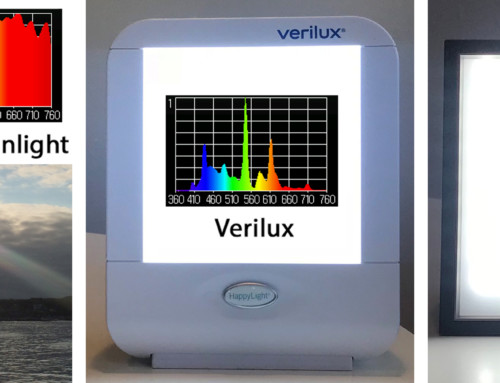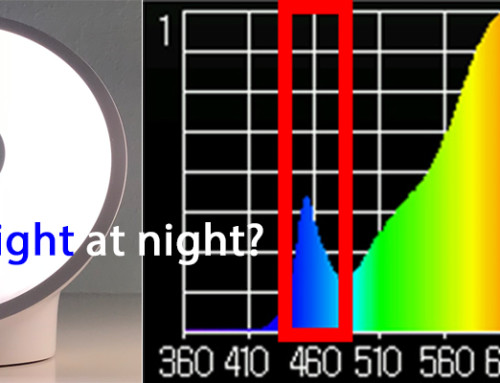Flicker is common characteristic of most artificial (man-made) light sources, and another way that artificial light is different than natural light (which has no flicker). Flicker is due to the way light sources are powered and depends upon the type of ‘lamp’ as well as the electronics used to drive the light-source. The electricity which comes out of a regular wall socket alternates at 50 or 60 Hz (AC = alternating current) which means the power feeding most lights is cycling on/off 100 or 120 times a second. As a result, many light sources flicker at 100 or 120 Hz, since they have power twice in every cycle. Almost all artificial light sources are associated with flicker, including TV screens and computer monitors. Flicker is a known cause of headaches and eye strain and has also been tied to reduced concentration and visual performance. Studies show that some individuals are more sensitive to flicker than others. In addition to headaches and eye-strain, flicker can increase heart rate, induce dizziness or nausea and even trigger seizures. Unfortunately, the commonly used flicker metrics don’t provide enough information to judge the quality of a light source. Here we describe the health impacts of flicker, provide measurements of common light sources (incandescent, LED, fluorescent), and discuss what makes some artificial light sources more disruptive than others.
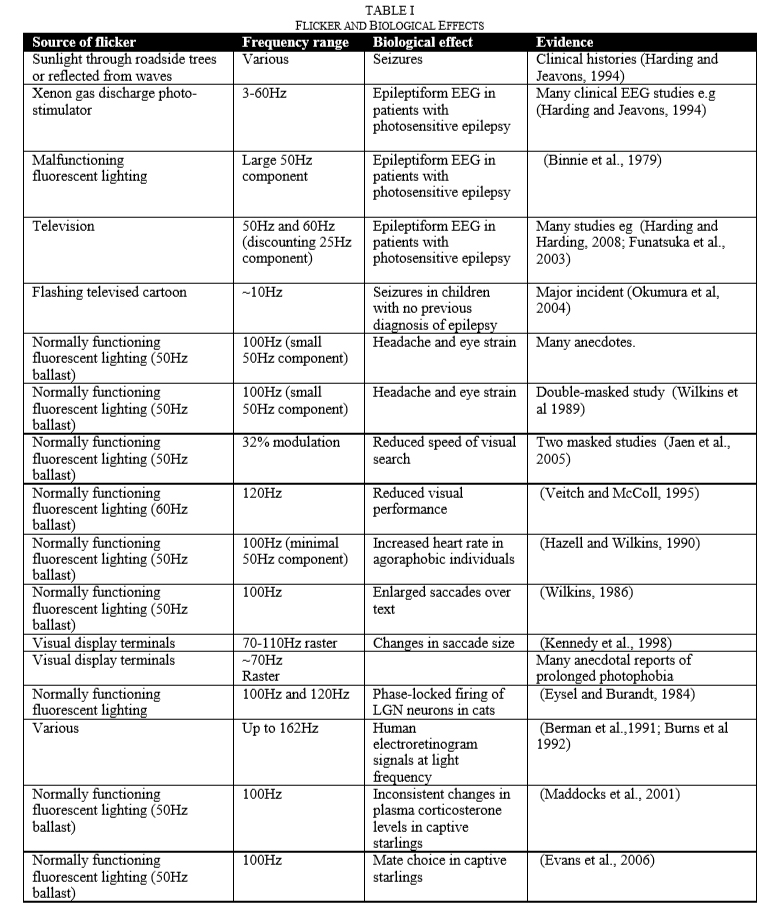
Documented effects of Light Flicker from various sources of artificial light (source).
Flicker refers to the change in the intensity of the light source as a function of time. In simple terms, the two things which matter are (1) how much the light intensity varies (flicker amplitude) and (2) how many times per second the light is flashing or cycling (flicker frequency). The two most common flicker metrics (flicker percent and flicker index) are a measure of (1) how much the intensity of the light varies. As you would expect the higher the number, the more the intensity or amplitude of the light varies (the worse the flicker). Old fashioned incandescent bulbs flicker at 100-120 Hz but with less than a ~10% variation in intensity/amplitude which is generally not enough to cause discomfort. Equally important is (2) the rate at which the light varies (how many flashes per second). As it turns out the slower the light cycles or flashes the more disruptive the flicker! First generation fluorescents (with magnetic ballasts) flickered at 100-120 Hz, leading to complaints of headaches and eyestrain. Newer fluorescents (with electronic ballasts) cycle at 20-60 kHz (>100x faster) which is thought to be outside the range of human perception – but most still have some 120 Hz oscillation. Poorly designed LED lights flicker at 100-120 Hz and can be quite disruptive, while higher quality LED lights flicker at lower amplitude and much higher frequencies. In an extreme case of disruptive flicker, a 1997 Pokémon cartoon showed flashes at 10 Hz (10 cycles/second) causing seizures in children with no prior history of epilepsy. Humans can see lights flicker up to 60-100 Hz (60-100 cycles per second) which is called the critical fusion frequency, but negative health effects have been documented at frequencies up to 200 Hz and there is speculation of impacts at even higher frequencies. Net-net the lower the flicker percent (or flicker index) and the higher the flicker frequency, the less disruptive the light!

Not all artificial light sources are created equal. Most cheap LED bulbs have moderate 120 Hz flicker. With proper electronics it is possible to design and build a light source with no flicker!
Guide to measuring Light Flicker:
(1) amplitude of the flicker (how much the intensity varies per cycle):
– Flicker Index = (Area 1)/(Area 1 + Area 2)
– Flicker Percent = 100% × (Maximum Value – Minimum Value)/(Maximum Value + Minimum Value)
*Flicker Index of less than 0.05, and/or a Flicker Percent of less than 10% are ‘good’ (the lower the number the better)
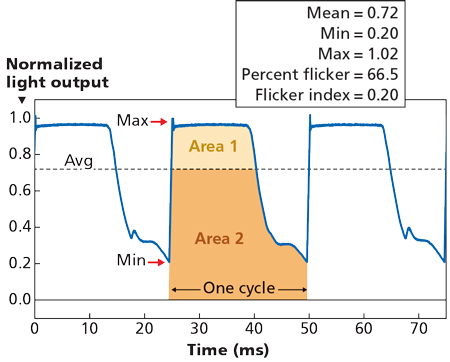
Flicker Percent and Flicker Index are two common measurements of the magnitude or amplitude of Light Flicker. For more on measuring flicker click here.
(2) frequency of the flicker (how many times per second does the light vary):
– Flicker Frequency = # of cycles / second
*Flicker Frequency of >500 Hz is ‘good’ (the higher the frequency the better)
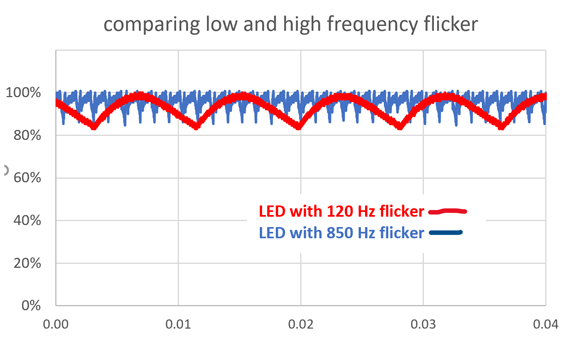
Comparing low frequency (120 Hz) and high frequency (850 Hz) light flicker. low frequency flicker (120 Hz) is much more disruptive than high frequency (>500 Hz) light flicker. Note that the amplitude of the flicker is the same, but due to the lower (120 Hz) frequency the red flicker is much more disruptive than the blue!
(3) flicker amplitude as a function of dimming (how flicker changes as you dim the lamp)
– Flicker Index and Flicker Percent at 50% dim and 95% dim levels
*Flicker Index and Flicker Percent should not increase dramatically as a light source is dimmed
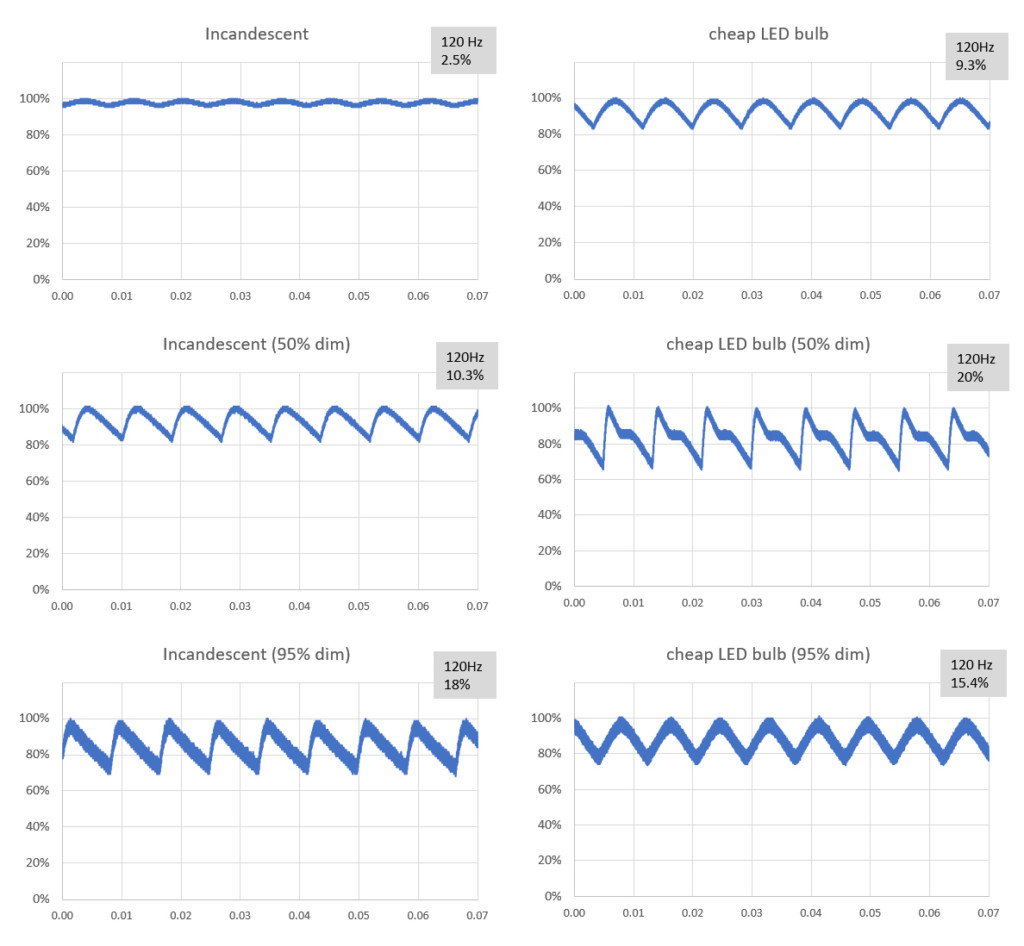
Flicker amplitude increases with dimming for incandescent and LED bulbs, while the Flicker Frequency does not change (stays fixed at 120 Hz).
Unfortunately there is no universally accepted standard for ‘safe flicker’ (maybe ‘safe flicker’ is just an oxymoron?), but practically speaking a Flicker Percent of less than 10%, and a Flicker Index of less than 0.05 is considered ‘good’ (the lower the number the better). While most artificial light sources flicker at 120 Hz, the higher the flicker frequency the better. Frequencies above 1000 Hz thought to be imperceptible for humans (no measurable biological/physiological impact). California has proposed setting a crude threshold of no more than 30% flicker for Title 24 regulations. The IEEE (Institute of Electrical and Electronics Engineers) has published a more nuanced set of ‘recommended practices’ under IEEE 1789. The IEEE guidelines take into account both the amplitude and the frequency of the flicker, and suggest a limit of no more than 8% Flicker in Europe (at 100 Hz) and 9.6% in the US (at 120 Hz). While these thresholds are not perfect, and some people are more sensitive to flicker than others, they do provide a useful framework.
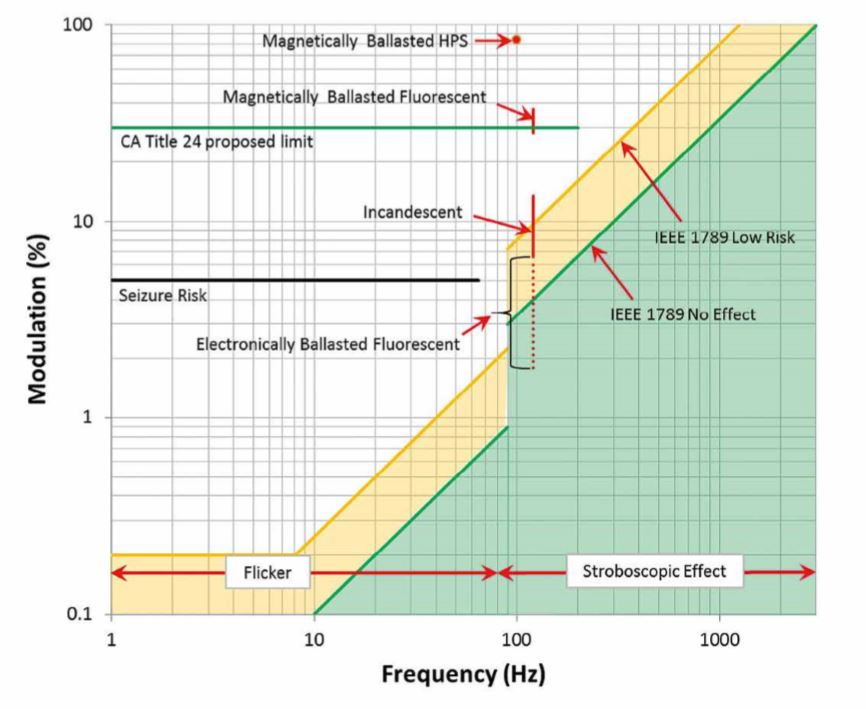
Summary of IEEE 1789 ‘Recommended Practices’ for Light Flicker. Light sources with a lower Flicker Percent and higher Flicker Frequency are less disruptive. (source of this figure).
Comparing the Light Flicker of various artificial light sources:
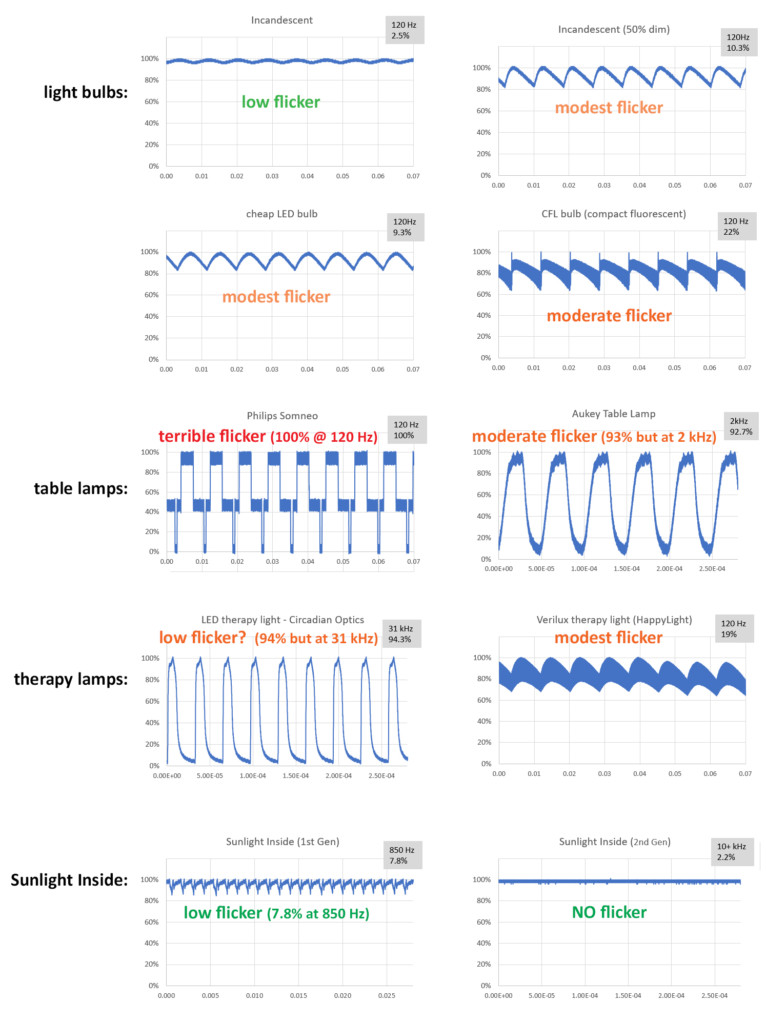
Additional reading and references about Light Flicker:
– Understand the lighting flicker frustration – high-level lighting industry overview on the topic of Light Flicker
– LED Lighting Flicker and Potential Health Concerns: IEEE Standard PAR1789 Update
– Potential Biological and Ecological Effects of Flickering Artificial Light
– Light Flicker from LED Lighting Systems – An Urgent Problem to Solve
– Designing to Mitigate Effects of Flicker in LED Lighting: Reducing risks to health and safety




